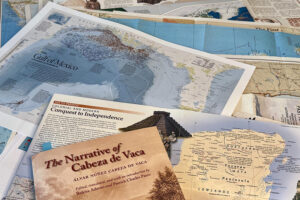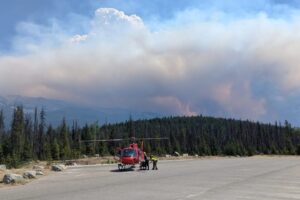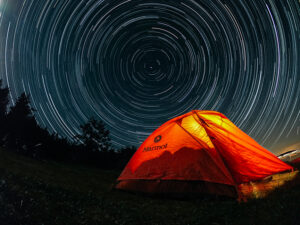Over my polar travels, I’ve spent about six months camping below minus 40°, and another year and a half at temperatures below -20°C. I’ve learned that cold’s not bad, even when it’s so extreme that pee freezes before it hits the ground. The key is having the right gear. If you’re poorly equipped, you may survive, but you suffer far more than you have to.
I wish I’d known about the stuff below when I was just starting out. It would have made those early expeditions a lot easier. And if you have a friend or loved one whose heart warms when the mercury freezes, the gift ideas below will keep them well-fed, well-oriented and well-dressed.

American frontiersman Daniel Boone was once asked if he had ever been lost. “No,” he replied, “but I was bewildered once for three days.” To avoid bewilderment in a whiteout, sled haulers use a compass tray to maintain a bearing without having to stop for a new reading every few steps. Its wide end belts around the waist and a cord on the narrow end loops over the head for support. Sometimes, you can go an entire expedition without using this device. Other times, it’s vital. $73.

Produced by ExWeb ambassador Eric Philips, these bindings let sledders ski with their feet couched in soft, warm mukluks (see below) or any footwear. You can’t carve turns with these; they’re made for shuffling forward while hauling a sled. $290.

Freeze-dried dinners for expedition appetites
Most freeze-dried dinners profess to “Serve Two” but don’t satisfy even one expedition appetite. But UK company Expedition Foods offers a line of 1,000-calorie meals that really will fill the hole after a long, cold day of trekking. $12.

Used on countless polar expeditions, these canvas-and-moosehide mukluks pair with polar ski bindings, above. If the snow is hard enough, you can even walk comfortably all day in them: Walking is often faster than skiing when pulling a heavy sled. The natural rubber bottoms won’t crack in the cold, and the boots come in normal width and extra-wide (essential for expeditions). They’re made by the Minnesota company founded by Patti Steger, former wife of polar veteran Will Steger. $200.

If you really want to splurge on a great gift for the would-be expeditioner in your family, give him or her a course that teaches the basics of polar travel, from dressing properly to dealing with cranky stoves. In Europe, many courses (like the title link) take place in Scandinavia. Polar training is not as common in North America, but Sarah McNair-Landry and her Northwinds company offer it out of Iqaluit, on Canada’s Baffin Island. $4,200 and up.

In the writing trade, Moleskine-type notebooks have a distinguished pedigree. Ernest Hemingway used them. So did Vincent Van Gogh and travel writer Bruce Chatwin. The original notebooks were handmade by French bookbinders in the 19th century. In the 1990s, an Italian company resurrected the style. They come lined or unlined, in a variety of sizes. The sewn spine won’t crack in the cold and the paper registers writing well. Now all the literary polar traveler needs is a good mechanical pencil. Ink freezes. $18 for the 12.7 x 7.6cm size, holding about 100 sheets/200 pages.

Surprise, surprise, most glue — think duct tape, most blister tape — doesn’t work at 30 below. The water in the glue freezes. But a few products use a medical glue that does work in extreme cold. One of the most convenient is Hypafix, which comes in rolls of various widths. Five centimetres is a good, all-around size. It serves not only as a blister tape — both preventive and ameliorative — and a bandage for wounds, but makes a fair substitute for duct tape. $12 for a 10m roll.

One of the great luxuries at the end of a sledding day is switching into warm camp clothes. There are many models of expedition parkas and down pants out there, but very few camp booties of equal heft. An exception is Western Mountaineering’s Expedition Booties. It reaches up to the knees, and the toe and heel areas have much more 800-fill down insulation than a typical cottage bootie. $130.

Protect the vulnerable gap between gloves and arm with a pair of Heat Company Wrist Warmers. The thin but warm Power Stretch material fits under almost any pair of gloves. Any gloves that are too tight in combination with these are not suitable for polar use, anyway. In milder temperatures, such wristlets even allow delicate repair jobs to be done with bare fingers. $35.

Polar trekkers often melt much of their next day’s water the night before, to save time in the morning. But there’s nothing worse than trying to sleep with a Nalgene-type bottle in your sleeping bag to keep the liquid from freezing. It starts off as a hot water bottle but soon becomes a cold-water bottle. A vacuum flask, like this classic one-quart Stanley, can just sit overnight in a corner of the tent, no matter how cold it gets. Prudent travelers insulate the bottle and integrated lid/cup at home with thin foam or moleskin to avoid handling metal. The cold penetrates even moderately thick gloves. $35.






